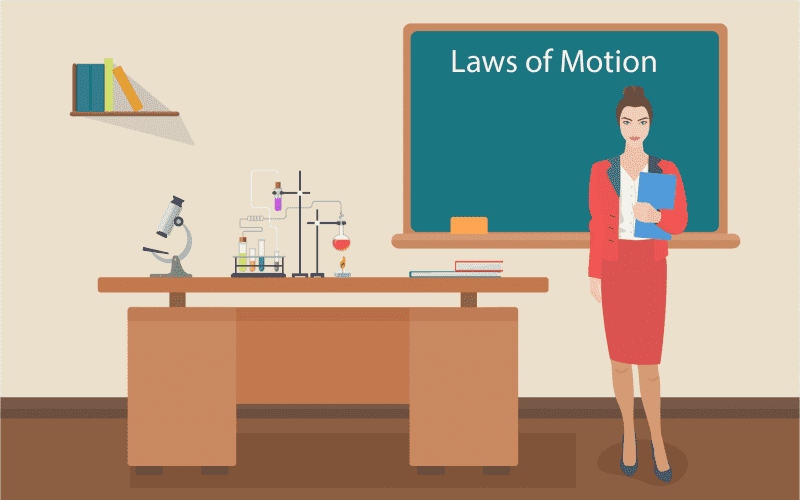From Kinematics and Gravitation to Rotational Motion and Mechanical Properties of Fluids, the Physics syllabus for class 11 covers various facets of the field in a very comprehensive way. One such topic, which explains the day-to-day happenings around us is Newton’s Laws of Motion. Bifurcated into 3 laws, establishing a hold over the concepts related to this topic is not only essential for international and government exams after 12th Science, but it also helps to understand a wide range of activities that occur on a daily basis. So, in this blog, we have collated all the necessary information pertaining to the laws of Motion class 11 syllabus.
This Blog Includes:
Laws of Motion Class 11: Important Terms
Before we delve deep into the concepts related to the laws of motion class 11, let us first understand some important terms which will be used throughout.
| Terms | Definition | Details |
| Inertia | It is a property of any object that makes it stationary until and unless force is applied. | The law of inertia also refers to Newton’s First Law of Motion |
| Force | Upon interacting with another object, the first object faces a push or a pull. This is called the Force. | Its S.I unit is Newton. Some of the major types of forces are: Frictional Force Gravitational Force Tensional Force Applied Force Electric and Magnetic Force |
| Linear Momentum | The product of a body’s mass and velocity is called linear momentum. | p=mv |
| Impulse | It is the effect of force that acts over a body over a period of time. I = F x Time | Symbol = J S.I unit = kg m/s or N-s |
| Conservation of Momentum | Following the 2nd and 3rd laws of motion, Conservation of Momentum states that when a collision between 2 objects occurs in an isolated system, the momentum stays conserved. |
Newton’s First Law of Motion
This law states that until external pressure is added, a body stays in its rest state or continuous motion in a straight line. This rule is also regarded as the inertia statute or the Law of Inertia.
Examples:
- The car at rest will not move.
- Football will move only when force is applied.
- Till it reaches the goal post, the hockey ball will continue to move.
Explanation of Newton’s First Law of Motion
The first Principle of Newton’s Law of Motion stipulates that, when an outside force behaves, an entity is in rest or uniform motion in a straight line. It can be considered as a declaration of inertia that things continue in their orientation until a force affects the motion. Every shift in motion means acceleration, accompanied by the Second Law of Motion. The first rule should only be regarded as a particular case of the second rule under which the total outside force is zero, but also includes some presumptions on the scope of reference for the motion. This forms a basis of laws of motion class 11 syllabus.
The Second Law of Motion
The next point in the Laws of Motion class 11 notes points towards the Second Law of Motion. According to it, a body accelerates due to unbalanced forces around it. This acceleration depends on the mass of the object and the net force applied. So, its equation is:
F = M x a
For Example: An individual may move an empty cart rather than a full cart more easily (depending on the weight of the item).
Explanation of Newton’s Second Law of Motion
The assertions of the Second and of the First Law of Motion here assume that the calculations are rendered in a frame of reference that does not intensify itself. Such a structure is labelled as an “inertial system.” If you are dealing with a rotating reference framework or an accelerating framework, the statement of those laws must be generalized.
A wide variety of physical processes are included in the Second Law of Motion, as mentioned below, but it is not a fundamental concept, such as the Conservation Laws. Only if the strength is the net external force is applied. It does not extend specifically to cases where the mass varies either as a consequence of material reduction or gain, or if the body moves near to the speed of light, and may have relativistic effects.
Newton’s Third Law of Motion
When it comes to the laws of motion class 11 syllabus, then understanding the third law is crucial. It states that an equivalent and an opposite reaction occurs with each action and all functions on two separate bodies.
Mathematically, F12 = – F21
Where F12 is the Force exerted on the 2nd body by the first
F21 is the force exerted by 2nd body on the 1st.
Prominent Examples:
- A man’s leap on a riverbank from a ferry.
- When the projectile is shot from a rifle, a jerk is made.
- Horse cart driving.
- While swimming, force is exerted on water and vice versa.


Explanation of Newton’s Third Law of Motion
The powers in the universe exist in similar yet opposite pairs. Every force is isolated; there is a force with similar magnetization in a different orientation, which corresponds to the body conducting the external force, with any external force acting on an entity. In the case of internal powers, a reaction force from one aspect of the mechanism is offset by another component, to reduce the net effect of an individual system on the whole network.
The Third Law of Motion states that since they arise from the two masses themselves, they would be of similar size, but opposite orientation such that no net power originated from strictly internal forces. Without specifying what the two masses’ existence or sources are, the forces must be equivalent.
Solved Questions –
Let’s answer a few questions to assess your understanding of this topic –
- What is the unit of coefficient of friction?
The coefficient of friction has no unit.
- Define force. Mention its SI unit.
Upon interacting with another object, the first object faces a push or a pull. This is called the Force. The SI unit of force is Newton.
- Who discovered the three laws of motion?
The three laws of motion were discovered by Sir Isaac Newton.
- What provides centripetal force to a car taking a turn on level road?
The force of friction between the tyres and the road provides for the centripetal force.
- Why are the laws of motion so important in our daily lives?
Newton’s laws are considered important because they relate to everything that we do or see in everyday life. These laws tell us how things move or stay still, why we don’t float out of our bed or fall through the floor of our house.
- Give examples of Newton’s Third Law of Motion.
Examples of Newton’s Third Law of Motion –
- When the projectile is shot from a rifle, a jerk is made.
- Horse cart driving.
- State the difference between Newton’s law of motion and Kepler’s law of motion?
While Newton’s Law of Motion is applicable for any motion, Kepler’s law of motion is applicable just for planetary movement in the solar system.
- State Newton’s Three Laws of Motion.
- 1st Law – This law states that until external pressure is added, a body stays in its rest state or continuous motion in a straight line
- 2nd Law – According to the second law, a body accelerates due to unbalanced forces around it. This acceleration depends on the mass of the object and the net force applied.
- 3rd Law – It states that an equivalent and an opposite reaction occurs with each action and all functions on two separate bodies
- What is linear momentum?
The product of a body’s mass and velocity is called linear momentum. Mathematically, it can be represented as p = mv, where m stands for mass and v for velocity.
- Calculate the net force required to give an automobile of mass 1600 kg an acceleration of 4.5 m/s2
Force can be calculated using the following formula : F=ma
Substituting the values in the equation, we get
F=1600×4.5
F=7200N
Hopefully, you are now clear about the important concepts covered in the Laws of Motion class 11 syllabus. Exploring career paths after class 12th? Not sure how to get started? Then take the assistance of the experts at Leverage Edu who will not only help you explore suitable subject combinations but will also provide guidance in university admissions!

 One app for all your study abroad needs
One app for all your study abroad needs





















 45,000+ students realised their study abroad dream with us. Take the first step today.
45,000+ students realised their study abroad dream with us. Take the first step today.

